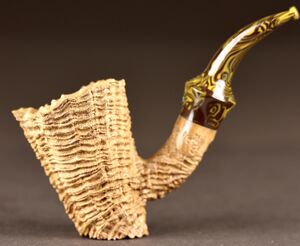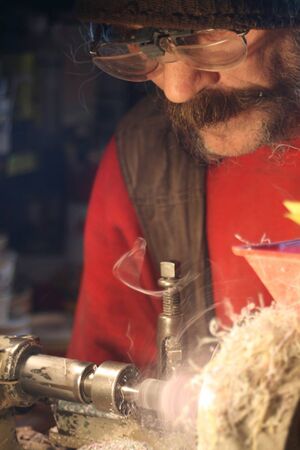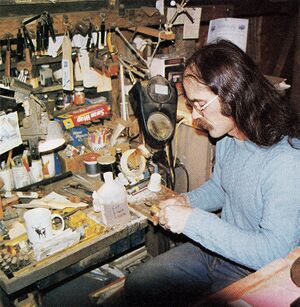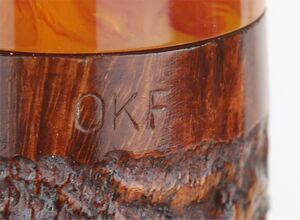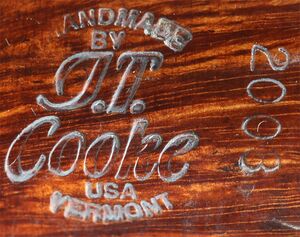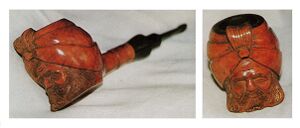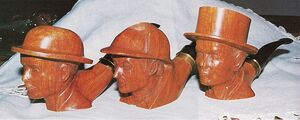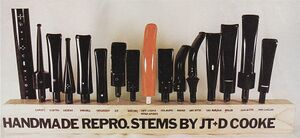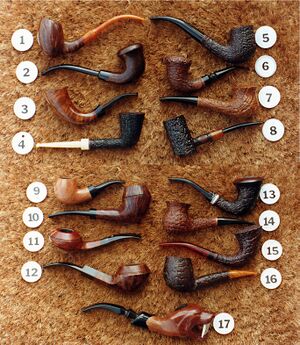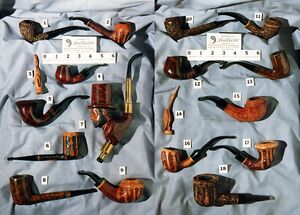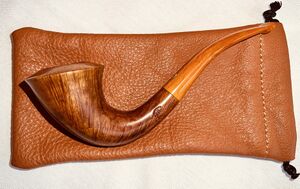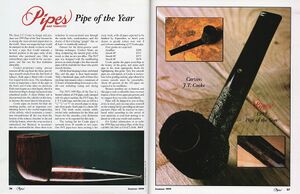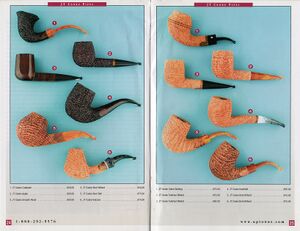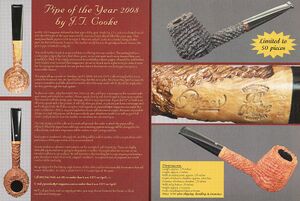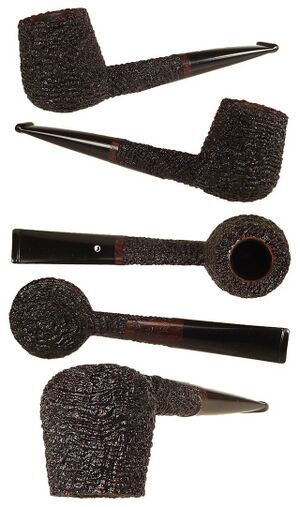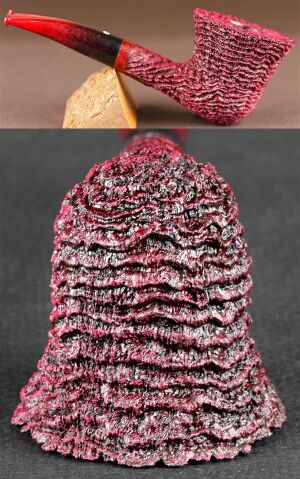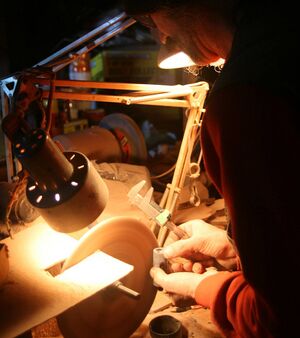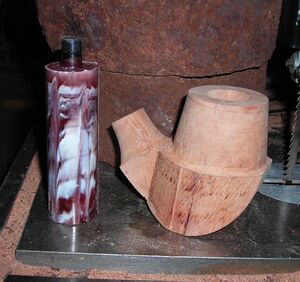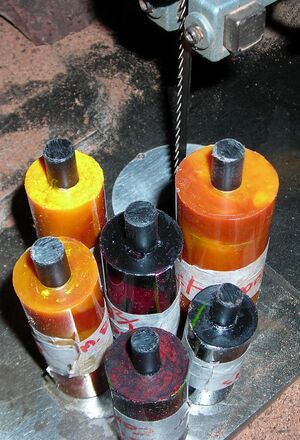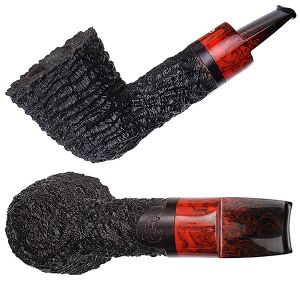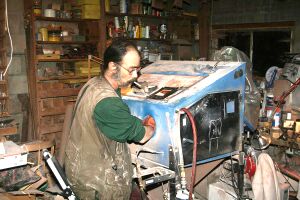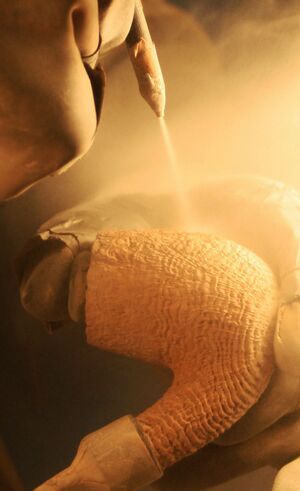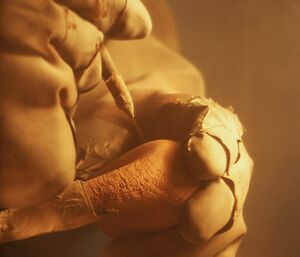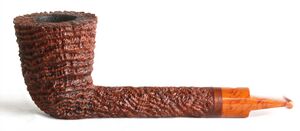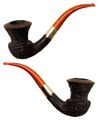Cooke, James T.
Vermont native "J. T." (James Tanner) Cooke, (b. 1949) has variously been called “the Bo Nordh of the blast,” “the supreme master” and “the Tessla of Sandblasting.” [1] In 2022, he was awarded Doctor of Pipes by the Chicago Pipe Collectors Club, the equivalent of the Hollywood Oscar for Lifetime Achievement. [2] He has made two pipes of the year for Pipes & Tobaccos magazine, one in 1999 (in a run of 250) and a second (in a run of 50) in 2008. In 2005, he made an edition of 25 straight dublins for the NASPC club pipe. [3] His pipes are renowned for offering a tactile and visual experience unlike any others in the world and his work is in such high and continuous demand that commissioned pipes have sometimes taken three to four years, resulting in a robust estate market where his pipes often sell for more than newly commissioned ones.
Design Language
J. T.’s design language can be understood as based in part on classic English shapes—particularly the Dunhill Shell and Barling Fossils—and in part on his own interpretations of current and past popular shapes, or what French pipe critic Erwin Van Hove calls “contemporary classicism.” [4] It is perhaps convenient to consider Cooke’s work as three organically evolving stages, similar to that routinely used by classical music critics.
The Early Period runs from Cooke's departure as Art Director for WCAX-TV in 1976 through about 1999. He pursued both pipe repair and pipe making first with The Briar Workshop and then with Levin Pipes International.
In the transitional Middle Period, J. T. set up under his own name, abandoned repair work and hung up his shingle as an artisan increasingly dedicated to sandblasting, which he has called “the bastard child” of pipe making. It ran from his first Pipe of the Year for Pipes & Tobaccos magazine in 1999 until around the time of his second Pipe of the Year for that magazine in 2008.
His work since then, the Late Period, demonstrates an increased dedication to executing his takes on classic shapes, the emergence of signature shapes, and a growing affection for chubby pipes, all with perfection of engineering and a sandblast execution without parallel.
Stamps and Nomenclature
J. T. has used three stamps in small capital letters at the mortise shank face to indicate the origin of his briar:
OKF— “Old Knarly Friend”—briar from Morocco
OGF—“Old Gnarly Friend”—briar from Italy (no longer used)
OKFA—“Old Knarly Friend Algeria" –briar from Algeria (no longer used)
There have only been two shank stamps indicating the authenticity of a Cooke pipe:
J.T. & D. Cooke—on pipes made before 1996; “D” refers to ex-wife Deb who teamed with Cooke as sander when they were making pipes for other American labels. [5]
J. T. Cooke—on pipes after 1996.
Cooke has disavowed the authenticity of pipes with the LPI shank stamp (for Levin Pipes International) as contract work, well-made but not genuine Cooke pipes. [6]
In addition, Cooke's pipes have always used the Chinese Yin and Yang for stem identification, appropriate since it symbolizes how opposites may actually be interconnected and interdependent: a non-dualistic understanding in which thesis and antithesis are transcended.
Early Period
By choice and good fortune, Cooke has followed the classic trajectory of continuous study and a long apprenticeship as journeyman before setting up shop under his own name. He made his first pipe in 1972 from a pre-carved block of briar, which he smoked while quitting cigarettes. He later carved it into a turbaned, bearded figural. [7]
In partnership with his ex-wife Deb, Cooke worked making pipes for The Briar Workshop and the Wilke pipe shop. They also did rough shaping for Mike Butera’s pipes as well making thousands of pipes under the LPI Levin Pipes International stamp. [8]
Barry Levin of Levin Pipes International (LPI) was a close friend of Cooke’s until his death and was instrumental in Cooke’s growth as a pipe maker, providing J.T. with the opportunity to study thousands of pipes as he restored them. An important outgrowth of his partnership with Levin was Cooke’s interest in creating reproduction stems, which would lead to creating his own hand-poured acrylic stems. [9]
After Levin's passing, in 1990 the Cookes began marketing their own pipes. J.T.’s facility and artistry are on display in two sets of photographs sent to prospective pipe shops at this time, showing a striking cavalier figural of Abraham Lincoln, smooth and sandblast free hands, classic shapes and “Icicle” rustic and smooth combinations resembling Castello and Radice’s melted wax-style pipes.
These photos show the range and sophistication of his work at this time, including the growth of his distinctive signature style based on his deep appreciation of classic English shapes . The bell calabash, horn, standing poker and bulldog are all shapes to which he will frequently return in his later work.
Middle Period
The transition to J. T.’s Middle Period is easily dated from the 1999 Pipe of the Year he agreed to make the first Pipe of the Year for Pipes & Tobaccos magazine, following on the heels of the important 1997 interview with editor Chuck Stanion in that magazine. By this time sandblasting had become Cooke’s métier as an artisan. As Stanion writes,
J.T. designs his pipes to be sandblasted. That is, unlike those who try to make a smooth pipe and then sandblast it when necessary, he designs a pipe so the proportions will be correct after sandblasting. J.T. knows classic shapes and is a stickler. All that experience with Dunhill and Barling classics made him a devotee of traditional shapes. In my opinion, J.T. Cooke is nearly alone in his ability to make a perfectly proportioned, sandblasted Billiard . . . . His pipes can appear a little on the chunky side until you realize that you're just not accustomed to seeing sandblasted pipes with proper proportions. Generally, deep, craggy blasts are necessarily reduced from their original proportions. Not so with Cooke pipes. [10]
Produced in an edition of 250 pipes, J. T. used the opportunity to “try to perfect his blasting technique” as Stanion recalls. “I learned something new with every pipe,” Cooke said. “Can you imagine what a perfect classroom that was? All the same classic Billiard shape, no confounding factors. I think I blasted all but six of those 250 pipes. That experience was like having the keys to the candy store. Total immersion in the blasting process. What an education.” [11] The overwhelming demand of creating this many pipes, however, led to severe carpal tunnel syndrome which required surgery in January of 2000. [12]
Late Period
The Late Period, again while somewhat arbitrary, is conveniently dated by the second Pipe of the Year for Pipes & Tobaccos magazine in 2008, reinforced in the ephemera on Cooke by an important double-page spread of his pipes appearing in the spring 2008 Uptown’s Smoke Shop catalog. In the catalog we see the mature, fully-developed style—not that Cooke hadn’t made such masterpieces before—but now, the pages seem to say, this is what Cooke does, this is who he is as a pipe maker.
Notice that while there’s only one smooth shape on the page, his abiding interest in classic English shapes is amply represented. There’s also, however, a volcano and a hawkbill, shapes newly in vogue at the time of the catalog and important in testifying to J. T.’s interest in current tastes and trends. The straight billiard—always a Cooke favorite—is also well represented. The Cobra Bulldog, which will be a Cooke signature shape, has also been developed by this time.
Finally, notice the stem and stain work: in addition to black, the reproduction amber is also in evidence, as are the custom-color swirl stems in the volcano and the hawkbill (#4). Cooke's three stain colors are also in evidence: the black (a midnight purple), the brown (which varies according to the wood used) and the natural, the most difficult to produce.
Cooke also agreed to do a second Pipe of the Year for Pipes & Tobaccos magazine for 2008, a distinctive brandy in an edition of fifty numbered pipes.
While J. T.’s shape catalog has become more and more distinctive and uniquely his own over the past ten to fifteen years, there is constant experimentation and new shapes still appear with regularity. [13] For example, the Christmas Bell, a dublin bell shape with special stain and custom stem, has appeared since 2016, but only one is made annually, just before the holiday.
Engineering
“I average one pipe a week, and that is a a long week of work.” —J. T. Cooke (2022) [14]
Airflow
It goes without saying that pipe smokers are initially attracted visually to the pipes they choose to smoke. Far more important but either ignored or underestimated is a pipe’s engineering, on what’s going on inside the pipe. When J. T. parted from Briar Workshop upon their relocation to Florida to make his own pipes, he was, writes Chuck Stanion, “entranced by the possibilities of improved internal engineering and the reduction of smoke turbulence within a pipe.” [15]
The opportunity to work for Barry Levin of Levin Pipes International gave J. T. the opportunity he needed for an intensive period of hands-on study. As Stanion writes of the thousands of pipes Cooke refurbished for Levin,
He took them apart and measured every aspect. Those that couldn’t be saved were dissected (he still regularly slices his own stems down the middle to check on the internal construction). He began to see what worked and what didn't and attributed it to engineering. The pipes that were clearly loved by their owners had precise machining, careful measurements, no moisture trap that clogged the airflow with gurgle or pipe cleaner fuzz or gunk. As thousands and thousands of used pipes went through his hands, and he saw with his own eyes what attributes contributed to a fine smoking instrument, his theories on airflow stabilized and he began applying what he learned to his own pipes. [16]
The first thing J. T. seized upon was the moisture trap at the junction between mortise and tenon. In the 2008 interview at Pipes & Tobaccos we learn that
[T]he mortise and tenon joint is carefully constructed, with the chamfered tenon reaching to the bottom of the mortise, where the smoke hole is slightly recessed to accept a tight fit with the tenon to reduce the collection of any residue or moisture. The smoke hole from the heel of the bowl all the way to the lip button maintains the same circumference, even with very flat bits, so there is no reduction in airflow that might cause condensation. [17]
Curing
“Cooke’s curing method,” writes Chuck Stanion, “takes up to two weeks and reduces the weight of the briar from 4-9 percent, depending on the individual block, and his method cures primarily the smoke channel and tobacco chamber, providing flavorful briar that absorbs moisture, so it’s important to keep a J.T. Cooke pipe clean for that carefully developed system to do its job of providing a dry and effortless smoke.” [18] The curing process can take anywhere from a few days to a few weeks, depending on the block of briar, and is done after the lathe work has been done and chamber bored but before the sandblasting. Cooke’s propriety process is done in two stages by first forcing the resins and tannins to expand and second apply a special solution to dissolve the resins and tannins. [19] As J. T. explains to David M:
I know guys like to age their briar. Some say for 2 or 3 years. I learned in my experiments with Barry [Levin] that there is a lot of stuff in briar, even the best briar . . . . So what I learned is that after I turn the pipes on the lathe, I put a dummy stem on them and I run them through a curing process, remove what residual tar and oils and sap is still in the wood, I leach that stuff out and then I dry the wood. Most cutters do an admirable job, because it’s a competitive industry like anything else, they do a great job of cleaning the wood as best they can. But they are cleaning 50 or 100 blocks at a time. And there is no way they can get all the stuff out. Plus, they are trying to get some stuff out of a big hunk of wood. I am trying to get the sap out of the turned pipe so it is a smaller process. The difference in a pre-cured block of wood and a post-cured block of wood is that I can drop the weight between the two between 6 and 9%. When I started actually weighing and charting the whole thing, I knew I was getting stuff out but it blew my mind that there was so much stuff in even the best block of wood. And it’s important because you want the block to be able to breathe. If you have a dry block that still has sap in it and over the years, the sap polymerizes. Once that happens, there is no way to get rid of it and it sets up like epoxy in the pores. The pipe will be heavy, not particularly absorbent. [20]
This curing process and the proprietary bowl coating J. T. applies results in pipes that are not only deceptive in their weight—being lighter than seems possible—but offering incredible smoking experiences from the first match light.
Blasting
Cooke writes, “Five stage blasting began around 1999. It’s never a hard and fast rule; it all depends on what the briar needs.” [21] In “Down this Blasted Path,” the short essay Cooke provides on his website, he details the stages:
1. The first stage shows me the over-all grain pattern and how the growth rings are oriented. This is where most (not all) pipe labels stop.
2. The second blast stage exposes and defines the hard and soft areas within the grain and ring patterns.
3. The third stage brings up even smaller patterns within each individual ring and details both hard and soft areas.
4. The fourth blast stage gently but firmly re-establishes the criss boundaries already created by previous blasting.
5. The fifth and final stage gives final detail to all the tiny individual fibers of wood. [22]
Stems
Cooke has made his own hand-poured acrylic stem rod almost from the beginning of his work as a pipe maker. He works primarily with three colors: reproduction amber (his earliest), amber bark and black. He also, however, frequently uses ruby (a deep purple swirl) as well as creates custom color combinations.
Even with J. T.’s standard colors, however, no two mixed-color stems will ever be alike, as the poured “colors can end up in all different locations and patterns on the stem.” [23] The uniqueness of such pipes is thus further enhanced, often strikingly so. Because these are hand-poured acrylics, they are more flexible than factory acrylic and one of the only instances in the artisan world of a pipe maker creating as well as turning stems for his own pipes.
Biography
Cooke was born in Connecticut in 1949 and has one sister (a retired university professor) and two grown children. [24] His father was a biology teacher with exceptional DIY skills which the his son would inherit, later building his own house from scratch. [25] As a child, J. T. experienced recurring high fevers from severe bouts of strep throat. In the interview with David M., he attributes his sickliness not only with developing his imagination but with giving him a certain existential outlook on life: “I had a certain appreciation for trying to enjoy every day because I never knew if it was going to be my last [which] gave me a certain amount of license to experiment and live life and pursue what I wanted to pursue, because nobody is guaranteed tomorrow.” [26]
In 1972, Cooke graduated from the Rhode Island School of Design with a Bachelor of Fine Arts in Illustration. [27] It is worth mentioning that this prestigious school, which has a steep 27% acceptance rate, includes alumni like David Burne of the Talking Heads, actor James Franco, authors Chris Van Allsburg and Brian Selznick (both Caldecott Medalists), and film maker Gus Van Sant among others. [28] Cooke is undoubtedly RISD’s only artisan pipe-maker.
On graduation, Cooke took a job with television station WCAX as its Art Director, where he worked through the mid-seventies. He decided he wanted to stop smoking cigarettes and his wife Deb bought him a carve-it-yourself pipe kit. “After I made the first one,” he recalls, “I knew that I finally found something that I was totally captivated with.” [29] A year or two later, he took a job at The Briar Workshop working for Elliott Nachwalter and Jorg Jemelka. [30] The Briar Workshop laid the groundwork for American artisan pipe making and included Danish designer pipe maker Finn Meyan Andersen and Cooke’s good friend Brad Pohlmann. [31]
When the Briar Workshop relocated to Florida a few years later, Cooke remained in Vermont to make his own pipes. Not long afterwards he met Barry Levin of Levin Pipes International (LPI), located in Craftsbury, Vermont, who is widely regarded as the founding father of the estate pipe market in the US. While LPI sold some of Cooke’s first pipes, the company was more important in providing him the opportunity to restore and study thousands of pipes, laying the foundation for his understanding of airflow, engineering and design language. [32]
After Levin’s untimely death, J. T. continued restoring pipes on his own. The repetitive operations involved and sheer amount of work led to severe carpal tunnel syndrome. “I came very close to losing my pipe making career,” he recalled. His fans and friends in the hobby, knowing of his plight, took up a fund and, unbeknownst to Cooke, collected enough money to allow him to have the operations he needed in January of 2000, which didn’t cure the problem. Knowing he would have to make a change, J. T. gave up restorations in favor of full-time pipe making. [33]
While Cooke’s earliest sandblasts involved a two-stage sandblasting process, as his career has progressed the blasting has evolved to three and then four or five stages, depending on the density of the wood and size of the bowl. Since the 1990’s, J. T. has supported many pipe shows by taking a table and always has enjoyed talking to attendees and working with collectors. Listening to his customers has led him to develop certain shapes like his classic bent bulldog. In 2010, working with Rich Esserman, Cooke utilized the lines of old Dunhill magnums and made his own style of Magnum bents and billiards. [34] Since that time Cooke has been immersed in the continuing pursuit of excellence in his blasting and engineering, continuing to refine and perfect his pipes.
Achievement and Legacy
Cooke’s sandblasting and stem work have occasionally been misunderstood, the former because because the buttons are perceived too boxy or uncomfortable and the latter because it is somehow not true sandblasting but a kind of rustication highlighted by sandblasting. As for the stems, Erwin Van Hove in the French Pipe Mag in 2003 said “Cooke is . . . famous for his comfortable stems.” [35]
“I know there are people out there who earnestly believe these pipes get carved at some stage in the process,” J. T. told Chuck Stanion. “I want to be clear about this: A carving tool never comes near one of these pipes. . . . This is sandblasting pure and simple.” [36] Doctor of Pipes Fred Hanna addresses Cooke’s sandblasting in a widely-circulated article originally appearing in the NASPC's Pipe Collector:
Some few collectors believe that Jim Cooke’s sandblasted pipes are actually ‘sand carved.’ Some have interpreted this as implying that Jim’s method has deteriorated the sandblasting art into a form of rustication that is then gone over or highlighted with sandblasting. This is misleading and possibly denigrates and negates Jim’s excellent work, which I believe is simply the best sandblasting ever done anywhere, at any time. Actually, the belief is quite puzzling in many ways. When one thinks about it, all sandblasted pipes are ‘sand carved’ to some degree and in some way. That is why the blasting is done! In making a single pipe, Jim told me that he spends from twelve to fifteen hours on sandblasting alone, quite in addition to all the other time-consuming steps that go into that pipe. Does this make his sandblasts somehow different than most others? Of course it does! Jim’s three-stage method seems to consistently bring out more detail, depth and definition, in my opinion, than anyone. That is why his pipes are so damned much in demand. Jim Cooke is the ‘Bo Nordh of the Blast.’ Jim does not create false graining patterns with his technique. In fact, he told me that his first pass is done specifically to expose the grain patterns, which he further exposes and details in his follow steps. [37]
Cooke has undoubtedly been the catalyst in popularizing blasting so that the once lowly and “bastard son” of briar pipes is now seen on equal terms with smooth-finished pipes and by many smokers even preferred. "Doctor of Pipes" indeed.
Bibliography & Media
Hanna, Fred J. “The Best Sandblasted Pipes Are Being Made by Americans,” The Perfect Smoke (NASPC Press, 2012), pp. 145-47.
Cooke Ephemera (mailers to Uptown’s Smoke Shop with photos, 1980). M., David. “J. T. Cooke—In A Class All His Own,” Tobacco Days blog, August 8, 2011, http://tobaccodays.com/2011/08/j-t-cooke-in-a-class-all-his-own/. Accessed 1/4/2021.
“Spotlight on JT Cooke,” Uptown’s Smoke Shop Spring 2008, pp. 22-25.
Stanion, Chuck. J.T. Cooke Sandblasted Canadian (2008). Product Description, 004-009-13142, Smokingpipes.com.
—. Email to Mark Irwin on J. T. Cooke’s briar curing process. Tuesday, May 26, 2020.
—. “Master Blaster,” Pipes & Tobaccos Vol. 13, No. 1, Spring 2008, pp. 14-19.
—. “The Road Less Traveled,” Pipes & Tobaccos Vol. 2, No. 2, Summer 1997, pp. 42-50.
—. “The Tesla of Pipe Sandblasting,” Smokingpipes.com, The Daily Reader, August 3, 2018, accessed January 4, 2021.
Contact Information
J. T. Cooke
info@cookepipes.com
www.cookepipes.com
514 Apple Tree Point Rd
Burlington, VT 05401
Gallery
References
- ↑ Fred J. Hanna, The Perfect Smoke , 146; David M., “In A Class All His Own,” Tobacco Days, August 8, 2011. http://tobaccodays.com/2011/08/j-t-cooke-in-a-class-all-his-own/ accessed 1/4/2021; Chuck Stanion, “J. T. Cooke: The Tesla of Pipe Sandblasting,” https://www.smokingpipes.com/smokingpipesblog/single.cfm/post/jt-cooke-the-tesla-pipe-sandblasting , accessed 1/4/2021.
- ↑ Chuck Stanion, “Doctors and Masters of Pipes: A Timeline,” https://www.smokingpipes.com/smokingpipesblog/single.cfm/post/doctors-and-masters-pipes-timeline?utm_source=Smokingpipes.com&utm_campaign=18848e7cd7-Sun_Jun_12_2022_DailyReader&utm_medium=email&utm_term=0_0e8b6a473f-18848e7cd7-209228005 , accessed June 12, 2022.
- ↑ http://www.naspc.org/Pipe%20of%20the%20Year.htm, accessed 6/10/22.
- ↑ Erwin Van Hove, “Go West!” reprinted in Pipes & Tobaccos, Spring 2004, 14-19.
- ↑ “In A Class All His Own.”
- ↑ “Tesla.”
- ↑ Chuck Stanion, “The Road Less Traveled,” Pipes & Tobaccos, Summer 1997.
- ↑ Email from Cooke to Mark Irwin, June 3, 2022.
- ↑ "Road Less Traveled.”
- ↑ Stanion, “Tesla.”
- ↑ Stanion, “Tesla.”
- ↑ “In A Class All His Own”; the operation took place January 2nd, 2000, per Cooke in an email to Mark Irwin, June 25, 2022.
- ↑ Making a regular visit to the Gallery page at www.Cookepipes.com reveals Cooke's on-going innovation as well as unifying aesthetic.
- ↑ Email to Mark Irwin, June 24, 2022.
- ↑ Stanion, “Tesla.”
- ↑ Stanion, “Tesla.”
- ↑ Stanion, “Master Blaster.”
- ↑ Chuck Stanion, J. T. Cooke estate pipe description, https://www.smokingpipes.com/pipes/estate/united-states/moreinfo.cfm?product_id=366182, accessed June 12, 2022.
- ↑ Stanion, “Master Blaster.”
- ↑ “In A Class All His Own.”
- ↑ Email from J. T. Cooke to Mark Irwin, January 3, 2022.
- ↑ J. T. Cooke, “Down This Blasted Path,” http://www.cookepipes.com/About.aspx, accessed June 12, 2022.
- ↑ Email from J. T. Cooke to Mark Irwin, June 11, 2022.
- ↑ In A Class All His Own.”
- ↑ “Tesla” and “In A Class All His Own.”
- ↑ “In A Class All His Own.”
- ↑ Email to Mark Irwin, January 3, 2022.
- ↑ https://en.wikipedia.org/wiki/Rhode_Island_School_of_Design
- ↑ “In A Class All His Own.”
- ↑ Stanion, “Tesla.”
- ↑ “Briar Workshop,” Pipedia, https://pipedia.org/wiki/Briar_Workshop, accessed June 13, 2022.
- ↑ Stanion, “Tesla.”
- ↑ Chuck Stanion, “Master Blaster,” Pipes & Tobaccos, Spring 2008, 14-19.
- ↑ Rich Esserman, email to Doctor of Pipes, March 19, 2022.
- ↑ Erwin Van Hove, “Go West!,” reprinted in Pipes & Tobaccos, Spring 2004, 14-18.
- ↑ Stanion, “Master Blaster.”
- ↑ The Perfect Smoke, 146.
